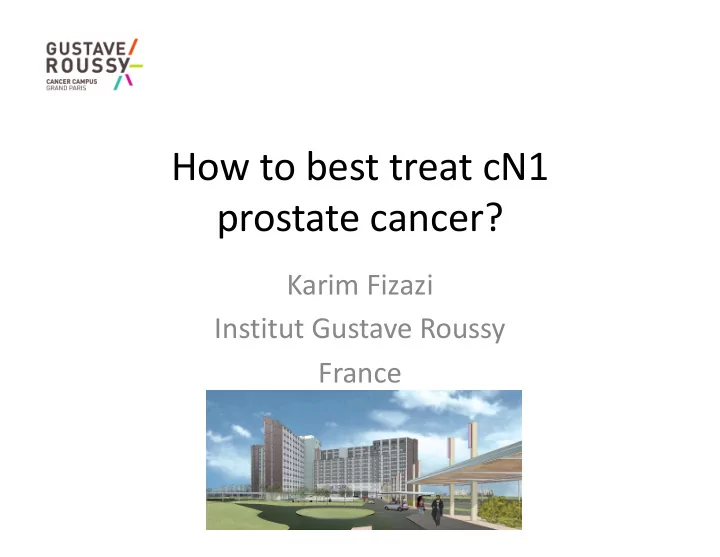

How to best treat cN1 prostate cancer? Karim Fizazi Institut Gustave Roussy France
Disclosure Participation to advisory boards/honorarium for: Astellas, AAA, Bayer, Curevac, Janssen, MSD, Orion, Sanofi
Randomized controlled trials in prostate cancer T3N0 M1 N1 > 100 RCT > 20 RCT ≈ 0 RCT
Radiotherapy for cN1? Yes or no? T2-3, N0, M0 T2-4, Nx or N0, M0 = localized prostate cancer
Non-randomized STAMPEDE data cN1 Relapse-Free Survival by RXT use STAMPEDE control arm (ADT), 2005-2014 n= 286 pts with cN+ M0 (and n=434 pts with cN0M0) cN+M0 HR=0.48 (0.29-0.79) RXT No RXT OS=Immature James N, JAMA Oncol 2016; 2: 348-57
RXT benefits may extend to cN+ men, although biases may explained better outcome… RXT not planned RXT planned James N, JAMA Oncol 2016; 2: 348-57
There are also likely biases in the US National database analysis Patients in the control arm: Local treatment - Were older (p<0.001) n=2967 cN1 pts - Had a worse Charlson index (p=0.03) - Had worse insurance coverage (p<0.001) No local treatment - Had a higher PSA (p<0.001) - Had a higer Gleason score (p>0.001) Seisen T, Eur Urol 2018; 73: 452-61
Radiotherapy of the primary in oligo-M1 Randomized data from STAMPEDE Parker C, Lancet 2018
Radiotherapy for cN1? Field side. T, N0, M0 (and >15% risk of N+) = localized
Also quite weak evidence to support (or not) lymphadenectomy in cN1 Only n=51 pts with cN+ … Specific survival similar for cN0 and cN1 Moschini M, Eur Urol 2016
Abiraterone in high-risk M0 prostate cancer (STAMPEDE) • Cohort selection: Randomised by Jan-2014 N=1,917 Metastatic Non-metastatic N=1002 N=915 N0M0 N+M0 N=530 N=384 No RT RT RT N=70 N=314 N=519
Abiraterone: RFS in M0 subgroup (including cN+): STAMPEDE cN+ ADT+Abi ADT +/- Abi cN+ ADT James N, ESMO 2017
Pelvic vs retroperitoneal LN: really different?
No Not even talking about PSMA-Pe Pet detected nodes… a b 18 F-PSMA PET 18 F-PSMA PET/CT CT CT/LN Segmentation SUV max =12.5 SAD=6 mm SAD=5 mm SUV max =14.5 SAD=4 mm SUV max =17.9 SAD=5 mm SUV max =10.7 PSMA-1007 PET Giesel et al., Clinical Genitourinary Cancer 2017
proPSMA | Prospective randomized study of PSMA PET/CT vs conventional imaging Trial Design Objectives proPSMA will address whether PSMA PET/CT Patient Selection: untreated, biopsy-proven prostate cancer, being considered for curative intent treatment. Primary PSA ≥ 20 ng/mL or Gleason Grade Group 3-5 or clinical stage≥T3 § should replace CT+ bone scan •Accuracy Randomisation 1:1 for initial staging. PSMA PET/CT CT + bone scan Crossover to other arm unless ≥3 distant metastases Secondary It will not tell us how best treat cN1. Implementation of Final Management •Management impact •Health economics 6 months follow-up: repeat imaging •Radiation exposure •Reporter agreement Up to 54 months follow-up for PSMA negative patients •Safety Primary endpoint to be presented EAU 2020 Hofman et al BJUI 2018
Conclusion: cN1 • Insufficient level of evidence • Need more RCT, next-generation imaging • Current treatment: – ADT? Likely yes. Duration? – Local treatment of the primary Yes – Local treatments of nodes? Likely yes – Large fields/PLND? Likely better than small – Abiraterone? If STAMPEDE RFS data translate into clinical endpoint – Docetaxel? More data at ESMO?
Thank you ! APCCC 2019 Basel 29-31 August 2019 www.apccc.org
Recommend
More recommend